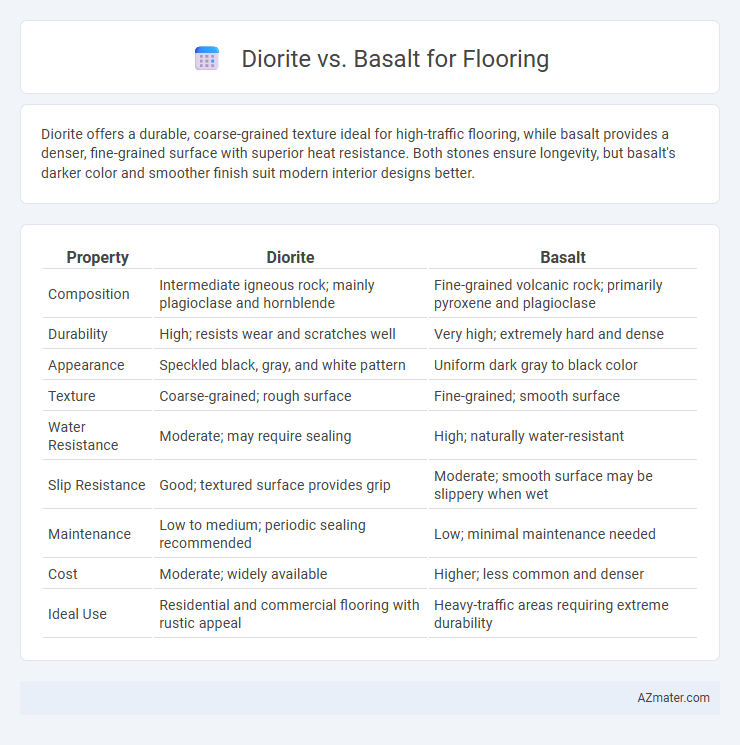Diorite offers a durable, coarse-grained texture ideal for high-traffic flooring, while basalt provides a denser, fine-grained surface with superior heat resistance. Both stones ensure longevity, but basalt's darker color and smoother finish suit modern interior designs better.
Table of Comparison
| Property | Diorite | Basalt |
|---|---|---|
| Composition | Intermediate igneous rock; mainly plagioclase and hornblende | Fine-grained volcanic rock; primarily pyroxene and plagioclase |
| Durability | High; resists wear and scratches well | Very high; extremely hard and dense |
| Appearance | Speckled black, gray, and white pattern | Uniform dark gray to black color |
| Texture | Coarse-grained; rough surface | Fine-grained; smooth surface |
| Water Resistance | Moderate; may require sealing | High; naturally water-resistant |
| Slip Resistance | Good; textured surface provides grip | Moderate; smooth surface may be slippery when wet |
| Maintenance | Low to medium; periodic sealing recommended | Low; minimal maintenance needed |
| Cost | Moderate; widely available | Higher; less common and denser |
| Ideal Use | Residential and commercial flooring with rustic appeal | Heavy-traffic areas requiring extreme durability |
Overview of Diorite and Basalt as Flooring Materials
Diorite and basalt are dense, durable igneous rocks commonly used for flooring due to their hardness and resistance to wear. Diorite features a coarse-grained texture with a mix of light and dark minerals, offering a speckled, elegant appearance ideal for high-traffic areas. Basalt presents a fine-grained, uniform black or dark gray surface prized for its sleek, modern look and excellent resistance to abrasion and staining.
Geological Formation and Composition
Diorite is an intrusive igneous rock formed from slow cooling of magma beneath the Earth's surface, composed mainly of plagioclase feldspar and hornblende, offering a coarse-grained texture ideal for durable flooring. Basalt, an extrusive igneous rock, solidifies rapidly from lava flows, characterized by its fine-grained texture and high content of pyroxene and plagioclase, resulting in a dense and hard surface well-suited for high-traffic areas. The differences in geological formation and mineral composition influence their hardness, porosity, and aesthetic appeal, with diorite typically exhibiting a speckled appearance and basalt presenting a more uniform dark color.
Physical Properties: Hardness and Durability
Diorite and Basalt are both igneous rocks renowned for their hardness and durability, making them excellent choices for flooring. Diorite exhibits a hardness of about 6 to 7 on the Mohs scale, offering strong resistance to scratches and wear, while Basalt ranges from 6 to 7 as well but is denser and slightly more resistant to impact and abrasion. The high compressive strength and low porosity of Basalt contribute to its superior durability in high-traffic areas compared to Diorite's slightly more granular structure.
Aesthetic Differences: Color and Texture
Diorite flooring features a striking, speckled appearance with a mix of light and dark mineral grains, offering a unique, salt-and-pepper texture that creates a sophisticated and elegant look. Basalt flooring, on the other hand, presents a consistent, fine-grained texture with a smooth, matte finish in deep black or dark grey shades, providing a modern and minimalist aesthetic. The color variation in diorite adds visual interest and contrast, while basalt's uniformity delivers a sleek, understated elegance ideal for contemporary designs.
Slip Resistance and Surface Finish Options
Diorite offers exceptional slip resistance due to its coarse-grained texture, making it ideal for flooring in high-traffic or wet areas. Basalt provides a denser, finer-grained surface that can be polished to a smooth finish but may require additional treatments to enhance slip resistance. Both stones allow for versatile surface finishes, with diorite favoring matte or honed textures and basalt supporting polished, honed, or flamed finishes for varied aesthetic and functional applications.
Installation Process for Diorite vs Basalt Flooring
Diorite flooring installation requires careful handling due to its coarse-grained texture and density, often necessitating specialized cutting tools and skilled labor to ensure precision fitting. Basalt flooring, known for its fine-grained structure and uniform hardness, is generally easier to cut and install, reducing labor time and costs. Both materials demand proper substrate preparation and sealing to enhance durability and resistance to moisture during the installation process.
Maintenance and Cleaning Requirements
Diorite flooring is highly resistant to stains and scratches, requiring minimal maintenance with regular sweeping and occasional mopping using pH-neutral cleaners to preserve its polished surface. Basalt offers a dense, non-porous texture that resists moisture, making it easy to clean with mild detergents and periodic sealing to prevent discoloration and maintain durability. Both stones demand prompt cleanup of spills to avoid staining, but basalt typically needs more frequent sealing compared to diorite to retain its appearance over time.
Cost Comparison: Diorite vs Basalt Flooring
Diorite flooring generally costs more than basalt due to its rarity and unique aesthetic appeal, with prices ranging from $10 to $15 per square foot compared to basalt's $7 to $12 per square foot. Installation expenses for both materials are similar, but diorite often requires specialized handling, increasing overall project costs. Basalt offers a cost-effective alternative with strong durability, making it suitable for budget-conscious flooring projects without compromising quality.
Suitability for Indoor and Outdoor Applications
Diorite offers exceptional durability and a polished aesthetic suitable for indoor flooring, providing a high-end finish resistant to wear and stains. Basalt's dense, fine-grained composition makes it ideal for outdoor flooring due to its excellent weather resistance and non-slip surface texture. Both stones perform well in various environments, but diorite excels indoors where visual appeal is prioritized, while basalt is favored outdoors for its toughness and safety under diverse weather conditions.
Sustainability and Environmental Impact
Diorite and Basalt both offer durable flooring options, but Basalt is generally more sustainable due to its abundant availability and lower energy requirements in extraction and processing. Basalt's natural resistance to wear reduces the need for frequent replacement, minimizing environmental impact over time, while Diorite's quarrying can cause more habitat disruption. Choosing Basalt flooring supports eco-friendly construction by lowering carbon footprints and enhancing long-term resource efficiency.

Infographic: Diorite vs Basalt for Flooring
 azmater.com
azmater.com